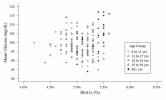But at my vintage of diabetes-years, there’s something about the A1c that feels like a grade from an ‘external examiner’, while sensor data has the feel of a ‘teacher assessment’. Ridiculous, I know. But I can’t seem to shake it.
I guess I'd probably feel the same way if I was a user of CGM of some variety.
Also, I guess I'd want to have a timeline of comparable data starting from before I started using CGM.
But I think there's areas where the difference becomes more significant. I see plenty of research studies where HbA1c is treated as an actual measure of BG. For example, studies pupporting to show elevated complication risk at "pre diabetic" or even high "normal" levels, but which use HbA1c as the measure, without any apparent consideration of the variability. This is face-value flawed, just because it is fairly common for somebody to have non-diabetic HbA1c but average BG above 7.8 mmol/l, ie at diabetic levels.
And once you get past the initial foundational studies establishing the empirical, conventional BG / HbA1c association, the correlation in more recent studies appears to be even lower. This might be an outlier:

buried in the supplementary data of a recent study of "normal" subjects:
https://forum.diabetes.org.uk/boards/threads/bg-profiles-in-healthy-non-diabetics.99521/
But it's a respected, highly-cited study, and as it says:
Overall, the correlation was weak (r = 0.27; 95% confidence interval, 0.12 to 0.41) between mean glucose concentration and HbA1c levels, and there was a wide spread of HbA1c levels for a given mean glucose concentration.
How much do you want to hang on a proxy measure with a correlation of just 0.27 with the thing you want to estimate? Bring on CGM for eveybody who needs to measure BG at a good level of accuracy: ie T1's, insulin using T2's, T2's while they are uncontrolled (not so much "normal", "pre diabetic" or reasonably well controlled non-insulin using T2 people).



